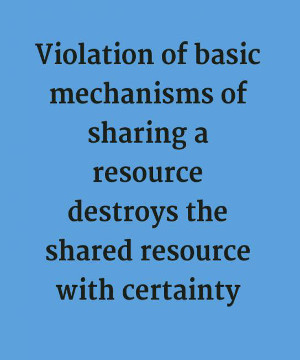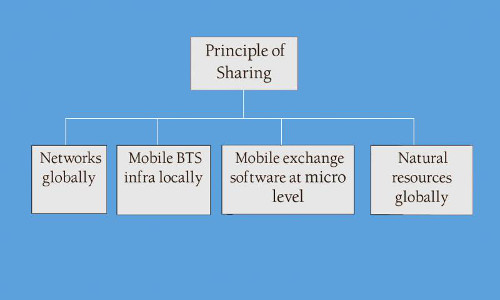The Importance of the Roles of Sharing in Solving Pressing Problems

Thinking of sharing is not enough—we need to understand the mechanism and role of sharing in solving pressing problems local or global.
How do we share?
Business domain sharing
This mode with its various versions is the most prevalent mode of sharing in all walks of life today. This is true for both the work and personal lives.
Both the global telecommunication network sharing of type A and the city mobile BTS infra resource sharing of type B, fall in this category. The guiding motive in these two scenarios is sharing and maximizing profit with clear-cut guidelines of sharing. Going to the next level of the sharing mechanism though, we find distinct differences between these two types of sharing scenarios.
Global sharing mechanism
In type A, a Telco network carries speech or data originated in another Telco, that is, share its own network resources for success of a unit of service, even though the traffic originating Telco is its competitor in the marketplace. What would have happened if this sharing were not done? Simply speaking, in that case, a voice call from network A to a network B of another Telco could not have taken place at all.
When many networks in a service domain are connected together globally, the domain market expands to its largest size and correspondingly business potential gets maximized. The sharing transactions are carried out strictly according to detailed guidelines, laws and methods agreed to by all players in the domain. Primary driving motive here remains to be maximizing market size and profits. These frameworks if properly formed, administered and maintained can potentially be highly beneficial to the end users instead of mainly to the service providers.
Global sharing also is used in many other domains of business such as: financial, airlines, supply chains, geographically disparate markets and so on. Together all these sharing results in what we fondly call Globalization.
These sharing mechanisms work only because no single player in any domain can cater to the whole market alone.
Local sharing mechanism
In type B sharing scenario where a number of mobile operators share rooms, roof space, equipment power and air-conditioning for their co-located BTSs, they do not share what they own. Rather the shared resources are owned by an agency operating in altogether a different market functional area.
Similarly, airlines share airport facilities administered by airport authorities or I and my fellow passengers share the public transport. For infra sharing, service is not a public service—it is Business to Business privately agreed and back-end service whereas for airport facility sharing all the actors—the airline staff of different airlines and the passengers operate simultaneously most of the time.
In all the above sharing models, gains are supposed to be maximized for all.
B2B sharing scenarios are governed strictly according to well-defined framework based on all-agreed guidelines satisfying all the business houses in the domain. In contrast, in B2B2C scenarios of public service such as roadways, airlines, transport, sewage, drinking water, power supply etc., sharing happens largely between customers or end-users. Complexity of rule formation and governance benefiting the service providers and the end-users simultaneously together is generally of a high order.
These problems are basically multi-objective multi-criteria decision making problems of high complexity and can be better dealt with by scientific MCDM methods.
In any public service, though end-user satisfaction should be the higher priority goal, many constraints usually might pose barriers towards achieving the desired goal.
Sharing sometimes creates loss
Till now from whatever we have discussed, it may seem that sharing is always gainful. But naturally it is not so. Assume that you had a car breakdown and had no other option but to travel to your destination by public transport. You are not used to such travel and suffer mental and physical discomfort. That is the loss in sharing public transport. It is limited to only people who are not used to this kind of sharing, and thus in totality, gains are positive (as majority of the people are used to sharing public transport facilities). This situation arises specially in those domains where service facility is limited and facility takers are more in number.
Situation is different when demand for service low
In countries where demand for public service is low, the situation is totally different. For example, in the city of Atlanta parking space in the downtown area is nearly impossible to get. The city has an internal railway system and most office goers find it convenient to park their cars in the rail station nearest to their homes and avail the not very crowded rail service to their offices.
What exactly does happen in this case? The large parking requirement of the downtown area is broken up or segmented (the first inventive principle of TRIZ is in action here) and then distributed over all the railway stations of the city. This is the view from City Planners’ angle.
From another perspective, the parking requirement of downtown shares the parking space of all the rail stations in the city and the office goers share the public rail transport for part of their office route.
Competitive markets
In competitive markets where does sharing come in? Yes, you know it already—customers for a market are shared albeit unwillingly (there is willing sharing and naturally the other side of the coin, that is, unwilling sharing) between the various competitors. Though a market is a battleground, the fighters are still forced to share the same market or segment of customers and try to win over as many customers as quickly as possible (simplistically speaking).
Stock markets
And stock markets? A stock market is based on shareholders owning a portion of share of the competing businesses and frantically trying in turn to make quick bucks from the invention of a stock market. Shareholding and stock market operations both are governed by detailed rule framework but in reality, the system is so very complex that no formula or problem solving mechanisms can be applied in this highly exciting game playing domain.
Positivity in totality cannot be controlled or guaranteed here as a rule.
Sharing of natural resources

Though we humans do not own the earth, we assume that we own everything natural and use and exploit the earth resources in such way to generate all material wealth that are perceived as wealth.
Ideally, it is a vast resource sharing domain where all living beings are to share the natural resources of the still beautiful earth following sharing laws of nature, to coexist in a balanced ecosystem.
In reality we humans have turned out to be the most highly active agents in intensely violating the basic sharing principles in this common environment.
Any share mechanism must have clearly defined share principles so that the benefits of share are maximized and shared resource is sustained. This is possible only if the delicately balanced ecosystem (in all domains, including business domains) is sustained. The ecosystem concept can be applied to human created domains also (by using domain mapping concepts). Sharing communication networks or sharing natural resources are no different. In case of sharing communication networks, the sharing principles, guidelines and laws are drawn out in fine details, but in case of sharing natural resources, vagueness of standards, laws and applied principles reign supreme.
What are the reasons behind this suicidal tendency? Can you say?
We perceive the basic reasons to be:
- Forced ownership for material wealth generation: as natural resources can’t be owned and material wealth can’t be created out of thin air yet.
- In case of forced ownership of any resource, use and exploitation happens without care and responsibility towards sustenance of the resources.
- Normal tendency is to assume - tomorrow would be the same as today. In other words general tendency is to take short term views.
- Most importantly, the true nature and implication of global sharing were not clear till recent past. Now, even though it is partly clear, it goes against human nature of doing best for oneself—not for others. Furthermore, now the situation is so immensely entangled in a web of unimaginable complexity that apparently none can make any dent in the problem.
Mark here that we are approaching the problem from the standpoint of understanding various aspects of the powerful sharing principle only. The advantage of approaching any problem from the angle of understanding the anatomy of basic principles involved in the problem domain is - it becomes possible to arrive at innovative solutions by tuning the principle characteristics, in this case characteristics of the sharing principle, only. By this approach, problem complexity can be reduced greatly.
Following is the concept structure of sharing principle:

Concept structure of principle of sharing
We would now narrate an example of problem solving by tuning the mechanism of sharing principle.
Story 1.
Long back while doing post graduation, I had to shift to a hostel accommodation as my father relocated on transfer. Though I got a confirmed seat in a good hostel, it was not available immediately. I was told I would get it after a month. Where to stay for this period was my problem.
I used to spend my evenings with one of my close friends who stayed in a single room in another hostel near the University. One evening sitting in his room I mentioned the problem and my friend casually said, “Not a problem. Stay with me.” I looked around the small room—there was no space at all for accommodating another cot and the existing cot was so narrow that only one person could just use it.
Now my problem was transformed to: “how to share the narrow cot.”
We did well without any fuss. We slept lying on the cot on our sides and facing away from each other using the smallest body print on the cot. We had quite a good control. There never was any movement of any of us and never any problem.
Even today when we remember the scene, we smile together and fondly say, “We slept like logs.”
